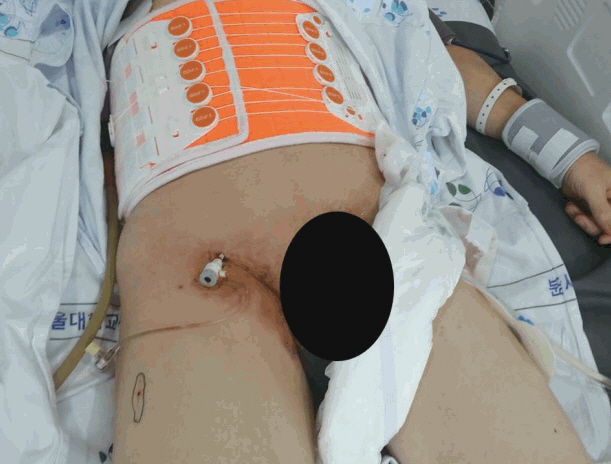Korean J Crit Care Med.
2015 May;30(2):115-118. 10.4266/kjccm.2015.30.2.115.
Resuscitative Endovascular Balloon Occlusion of the Aorta in a Trauma Patient with Hypovolemic Shock
- Affiliations
-
- 1Department of Surgery, Seoul National University Bundang Hospital, Seongnam, Korea. hanhs@snubh.org
- 2Department of Emergency Medicine, Seoul National University Bundang Hospital, Seongnam, Korea.
- KMID: 2227677
- DOI: http://doi.org/10.4266/kjccm.2015.30.2.115
Abstract
- Hemorrhagic shock is one of the most common causes of death in patients with multiple trauma and therefore rapid control of bleeding is the main strategy to save these patients. Resuscitative balloon occlusion of the aorta (REBOA) has been applied in several trauma cases and because of the effectiveness of this procedure it has been adopted in the trauma field. Herein, we report the first successful case of REBOA in Korea performed on a 46-year-old man with hemorrhagic shock after a fall from a height of 14-stories. The patient visited our hospital emergency room with hypovolemic shock, we performed Resuscitative Endovascular Balloon Occlusion of the Aorta under bed side blind technique. His vital sign was stabilized after procedure, then we could performed endovascular bleeding control. The patient was discharged on his 33rd in-hospital day without invasive procedure and major scar.
MeSH Terms
Figure
Reference
-
References
1. Sauaia A, Moore FA, Moore EE, Moser KS, Brennan R, Read RA, et al. Epidemiology of trauma deaths: a reassessment. J Trauma. 1995; 38:185–93.2. Willis CD, Cameron PA, Bernard SA, Fitzgerald M. Cardiopulmonary resuscitation after traumatic cardiac arrest is not always futile. Injury. 2006; 37:448–54.
Article3. Mehta M, Taggert J, Darling RC 3rd, Chang BB, Kreienberg PB, Paty PS, et al. Establishing a protocol for endovascular treatment of ruptured abdominal aortic aneurysms: outcomes of a prospective analysis. J Vasc Surg. 2006; 44:1–8. discussion 8.
Article4. Stannard A, Eliason JL, Rasmussen TE. Resuscitative endovascular balloon occlusion of the aorta (REBOA) as an adjunct for hemorrhagic shock. J Trauma. 2011; 71:1869–72.
Article5. Hughes CW. Use of an intra-aortic balloon catheter tamponade for controlling intra-abdominal hemorrhage in man. Surgery. 1954; 36:65–8.6. White JM, Cannon JW, Stannard A, Markov NP, Spencer JR, Rasmussen TE. Endovascular balloon occlusion of the aorta is superior to resuscitative thoracotomy with aortic clamping in a porcine model of hemorrhagic shock. Surgery. 2011; 150:400–9.
Article7. Sesma J, Labandeira J, Sara MJ, Espila JL, Arteche A, Saez MJ. Effect of intra-aortic occlusion balloon in external thoracic compressions during CPR in pigs. Am J Emerg Med. 2002; 20:453–62.
Article8. Spence PA, Lust RM, Chitwood WR Jr, Iida H, Sun YS, Austin EH 3rd. Transfemoral balloon aortic occlusion during open cardiopulmonary resuscitation improves myocardial and cerebral blood flow. J Surg Res. 1990; 49:217–21.
Article9. Brenner ML, Moore LJ, DuBose JJ, Tyson GH, McNutt MK, Albarado RP, et al. A clinical series of resuscitative endovascular balloon occlusion of the aorta for hemorrhage control and resuscitation. J Trauma Acute Care Surg. 2013; 75:506–11.
Article10. Ledgerwood AM, Kazmers M, Lucas CE. The role of thoracic aortic occlusion for massive hemoperitoneum. J Trauma. 1976; 16:610–5.
Article11. Moore LJ. Resuscitative endovascular balloon occlusion of the aorta(REBOA) is a feasible alternative to resuscitative thoracotomy in trauma patients with noncompressible truncal hemorrhage and profound hemorrhagic shock. In : 73rd Annual Meeting of AAST and Clinical Congress of Acute Care Surgery; 2014 September 10-13; Philadelphia, PA.12. Martinelli T, Thony F, Declety P, Sengel C, Broux C, Tonetti J, et al. Intra-aortic balloon occlusion to salvage patients with life-threatening hemorrhagic shocks from pelvic fractures. J Trauma. 2010; 68:942–8.
Article
- Full Text Links
- Actions
-
Cited
- CITED
-
- Close
- Share
- Similar articles
-
- Positioning of Resuscitative Endovascular Balloon Occlusion of the Aorta Catheter: A Case of an Elderly Patient with Concomitant Chest and Pelvic Injury after Blunt Trauma
- Educational Simulation Videos for Performing Resuscitative Endovascular Balloon Occlusion of the Aorta
- Resuscitative Endovascular Balloon Occlusion of the Aorta for an Iliac Artery Aneurysm: Case Report
- Effects of Resuscitative Endovascular Balloon Occlusion of the Aorta in Neurotrauma: Three Cases
- Advances in resuscitative endovascular balloon occlusion of the aorta (REBOA): a comprehensive review of the evolution, patient criteria, and technological innovations in trauma management



